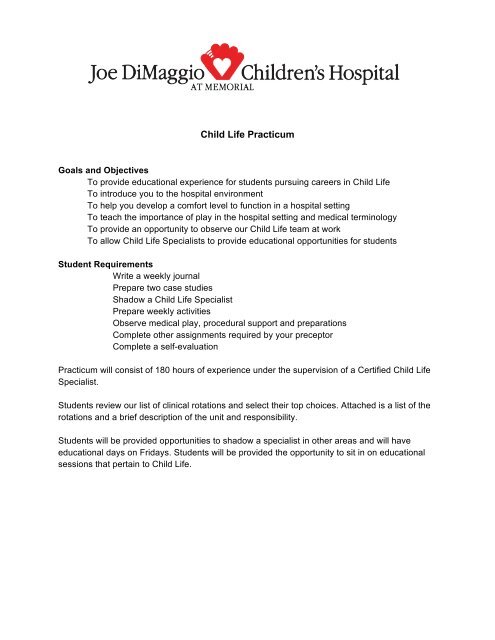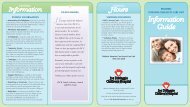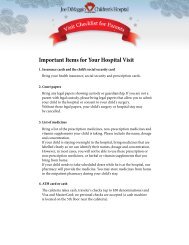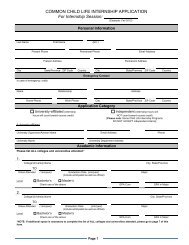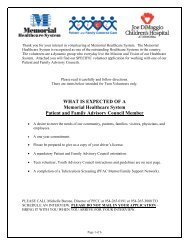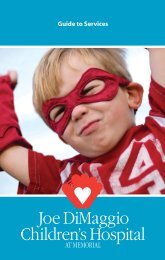Practicum description - Joe DiMaggio Children's Hospital
Practicum description - Joe DiMaggio Children's Hospital
Practicum description - Joe DiMaggio Children's Hospital
- No tags were found...
Create successful ePaper yourself
Turn your PDF publications into a flip-book with our unique Google optimized e-Paper software.
Child Life <strong>Practicum</strong>Goals and ObjectivesTo provide educational experience for students pursuing careers in Child LifeTo introduce you to the hospital environmentTo help you develop a comfort level to function in a hospital settingTo teach the importance of play in the hospital setting and medical terminologyTo provide an opportunity to observe our Child Life team at workTo allow Child Life Specialists to provide educational opportunities for studentsStudent RequirementsWrite a weekly journalPrepare two case studiesShadow a Child Life SpecialistPrepare weekly activitiesObserve medical play, procedural support and preparationsComplete other assignments required by your preceptorComplete a self-evaluation<strong>Practicum</strong> will consist of 180 hours of experience under the supervision of a Certified Child LifeSpecialist.Students review our list of clinical rotations and select their top choices. Attached is a list of therotations and a brief <strong>description</strong> of the unit and responsibility.Students will be provided opportunities to shadow a specialist in other areas and will haveeducational days on Fridays. Students will be provided the opportunity to sit in on educationalsessions that pertain to Child Life.
Emergency Department <strong>Practicum</strong>Clinical Rotation DescriptionsA visit to the Emergency Department can be an overwhelming and unexpected experience forpatients and their families. Child Life interventions in the Emergency Department involve quickassessments as the patient population continually changes, in order to determine how to besthelp children and families cope with and understand the events that occur during an EmergencyDepartment visit.Child Life interventions aim to normalize a patient's visit to the Emergency Department byproviding preparation for procedures, assistance in developing coping strategies, educationregarding what to expect and play opportunities. The Emergency Department serves patients ofall ages, from birth to young adult with varying medical diagnoses, injuries and acuity levels.The Child Life student will have a wide range of opportunities to improve his or her skills inprocedural preparation, procedural support, sibling support, stress and pain management andexpressive play while having multiple opportunities to be involved in the one-on-one care forpatients and families.The practicum student will be able to assist the Child Life Specialist in a variety of ways:* Planning and implementing therapeutic play activities* Participating in bedside play for normalization of hospital environment* Rounding on patients and families to assess their needs* Assisting Child Life Specialists with distraction during procedures* Providing comfort and support to patients and families in the waiting room and patient rooms3 Central/4 South (Medical/ Surgical)3 Central is a 24-bed medical/surgical unit hosting a variety of inpatients that consists ofcomplex surgery, ENT, orthopedic, cystic fibrosis, gastroenterology, etc. Patients’ length of staycan range from one night to a month or more. These patients can range from infancy to earlyadulthood.4 South is a 23-bed unit consisting of general med overflow. The patients on this unit areadmitted for pulmonary distress, seizures, infection, dehydration and many other conditions.Most patients are infants/toddlers, but can their age can range to adolescence.CL Specialists are responsible for preparation, medical play, procedural support, compliancewith treatment plans, expression of feelings, recreational play and patient/family education.These interventions are most often done on a one-on-one basis, but may occasionally includegroups.
The practicum student in this area will have a wide range of diagnoses to explore andopportunities to expand their knowledge base by adjusting preparation and providing support fora variety of diagnosis and related procedures. Patient interactions vary from one-timeinterventions to ongoing support for extended stays.Your experience on these units would include, but is not limited to, facilitating activities in theplayroom, shadowing Child Life on the unit, spending one-on-one time with patients, facilitatingdevelopmental play with infants/toddlers, observing procedural support/preparation done byChild Life and observing medical play done by Child Life.Hematology/Oncology Department (4 Central and Outpatient)Patient ages range from newborn to young adult. This unit is designed to treat oncologic andhematologic disorders such as bone marrow failure diseases, brain tumors, embryonal tumors,neuroblastoma, Wilms’ tumors, histiocytic disorders, leukemias, lymphomas, sarcomas of boneand soft tissues, spinal cord tumors, anemias, blood clotting disorders, platelets, sickle celldisease and thalassemias. Medical play, therapeutic art activities, emotional support andexpression of feelings are important aspects of this rotation. Child Life Specialists work withpatients to decrease the perceived limitations the diagnosis places on their daily lives byproviding therapeutic and emotional support while they are in the hospital. As a practicumstudent on this unit, you will be working with patients, parents and siblings regarding diagnosisand treatment. With your help and commitment throughout the various phases of each child’streatment, you can increase their coping mechanisms and help reduce fears and anxieties.About 10 patients per day visit the hematology/oncology outpatient clinic. Child Life offerssupport to patients receiving various chemotherapies, blood products, lumbar punctures, bonemarrow aspirates and routine exams or labs. These patients are only in the clinic for the dayand benefit greatly from therapeutic play/art activities to help keep them distracted.4 Central inpatient is a 24-bed unit designed for hematology/oncology patients hospitalized fortreatment. You will be exposed to immune-deficient patients who may be undergoing extensivechemotherapy, as well as sickle cell patients who have chronic pain. These patients tend to bein the hospital for extended periods of time. This unit also houses overflow of surgical patientsand those with diabetes.Specific unit expectations are as followed:• Observe inpatient and outpatient Child Life services• Participate in group and individual activities with supervision• Supervise playroom• Help with utilization of departmental resources• Facilitate therapeutic bedside activities
Infant / Toddler <strong>Practicum</strong><strong>Joe</strong> <strong>DiMaggio</strong> Children’s <strong>Hospital</strong> provides care for patients from newborn to early adulthood. Avariety of medical conditions are treated, including but not limited to, cardiac, oncology,hematology, pulmonary, renal, liver, gastrointestinal, infectious diseases, metabolic disorders,acute respiratory illness and those requiring ventilator support. Length of stay ranges from a fewhours to several weeks depending upon the diagnosis. Many patients have chronic illnessesrequiring repeated and lengthy hospitalizations.For babies, playing stimulates their senses and helps them learn and develop. Infant stimulationincludes activities that arouse or stimulate the baby’s sense of sight, sound, touch, taste andsmell. Infant stimulation can improve a baby’s curiosity, attention span, memory and nervoussystem development. In addition, babies who are stimulated reach developmental milestonesfaster, have better muscle coordination and a more secure self image.Why is infant stimulation important in the hospital? The hospital can be both understimulatingand over-stimulating. It’s important to pay attention to a baby’s special needs in thehospital, so you can continue providing appropriate stimulation. Being hospitalized is stressfulfor infants. Some things that can cause stress and affect a baby’s development:• The baby is touched by many different people — he isn’t used to so many people takingcare of him.• Medical care often interrupts the baby’s daily routine.• The staff or family members may not be able to respond to a baby’s needs as quickly asthey want to.• Some medical procedures may be uncomfortable or painful.• If toys are available, they may be out of reach.• Lights, beepers, alarms, IVs, etc. can over-stimulate a baby.• The baby might get bored being alone in a crib for long periods or in dull surroundings.Infant/Toddler practicum students will work with the Child Life Specialist to help with:• Facilitation of infant/toddler hour• Bedside play and diversion• Sensory stimulation• Normalization schedules• Encouraging expression of feeling
<strong>Joe</strong> D. TV is a closed-circuit television station accessible to our pediatric patients throughout thechildren’s hospital. <strong>Joe</strong> D. TV can be viewed on channel 46. The station features daily gameshows, arts and crafts, story time, JDCH News, Child Life Department updates, Patient andFamily-Centered Care news, and our schoolroom news. Our daily game shows are verypopular, featuring games such as BINGO, Pictionary, Hollywood Squares, Memory, Text Twistand Wheel of Fortune. Kids are invited into the playroom to play the games, and those whocannot leave their rooms can play right from their beds. Everyone can watch the live broadcaston their televisions. We have five lucky winners for every game show. Special guests andactivities are also filmed and shown on the station. <strong>Joe</strong> D. TV is managed by the Child LifeDepartment and can be viewed Monday through Friday.<strong>Practicum</strong> students will:• Facilitate set-up and break down for game shows.• Distribute fliers to all units for the game show. This requires speaking with patients andtheir families to inform them about which game is being played, a very brief <strong>description</strong>of how to play the game (including providing any necessary supplies) and the channeland time to tune in.• Host game shows• Create new shows• Add creative insight to contribute to the advancement of the station• Fine-tune operations• Create/incorporate new props and backdrops• Distribute prizesThis practicum is offered from noon to 4pm Monday through Friday (hours may vary).
Radiology<strong>Joe</strong> <strong>DiMaggio</strong>’s Radiology department caters to children from birth to age 21. OurRadiology area is a fast-paced, high-tech environment where most diagnoses are madeby ultrasound, MRI, CT scans, nuclear medicine and/or X-ray. During your practicum,you will learn about the different types of scans and distraction techniques that areunique to each area.<strong>Practicum</strong> students will be asked to:• Facilitate child-friendly medical play on our mini CT/MRI scanner• Help keep sedated patients awake after scans• Provide diversion activities for patients in waiting areas• Entertain patients’ siblings while scans are being completedAmbulatoryThe Ambulatory department caters to a diverse group of patients, including those whoneed special diversion during dialysis treatments that generally last about four hours.Dialysis patients also have a bi-Monthly Kidney Konnection meeting with a Child LifeSpecialist and a Psychology intern to share their feelings and learn diseasemanagementtechniques.We also assist video EEG patients who may be monitored by computer from 1 to 24hours, as well as patients visiting for hearing tests.Additionally, we see endocrine, hormone and infusion patients who are with us over ashort period of time for outpatient services.<strong>Practicum</strong> students will be asked to:• Help the Child Life Specialist during Kidney Konnection meetings• Provide diversion activities for patients who have long infusionsor treatment times• Organize large group play and games on dialysis daysCardiac/RehabThe cardiac unit is a three-bed outpatient unit that is part of the intensive care unit.Patients are seen in the outpatient unit for office visits, preadmission testing, cardiac
catheterizations and surgeries. The intensive care unit is half medical/surgical and halfcardiac, and patients are typically recovering from surgery, cardiac catheterization, orwaiting for a heart transplant. The six-bed rehab unit has many long-term patientsranging from toddlers age 18.Child Life Specialists are responsible for preparation, medical play, procedural support,compliance with treatment plans, expression of feelings, play, patient/family education,developmental stimulation, sibling support, as well as bereavement support. Theseinterventions are most often done on a one-on-one basis, but may occasionally includegroups.The practicum student in this area will gain experience and knowledge regardinghospitalization, cardiac surgeries and procedures, medical terminology, establishingrapport with long-term patients and families, daily schedules of inpatient rehab,developmental stimulation in the hospital setting, and more.Your experience will include, but is not limited to: facilitating activities (group andindividual), shadowing Child Life on the unit, spending one-on-one time with patients,facilitating developmental play with infants/toddlers, observing proceduralsupport/preparation done by Child Life, and observing medical play.


